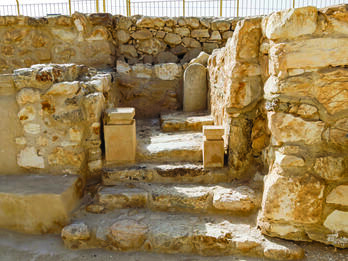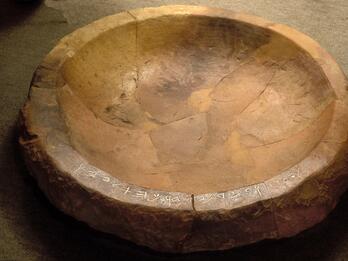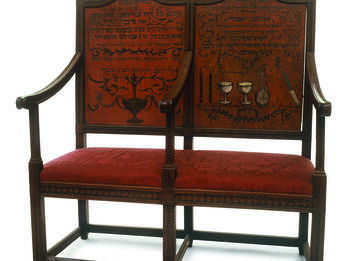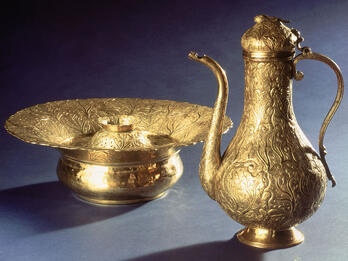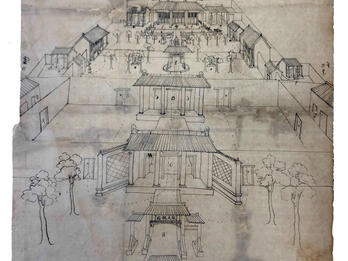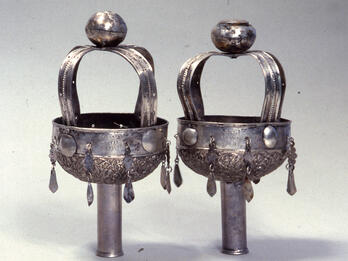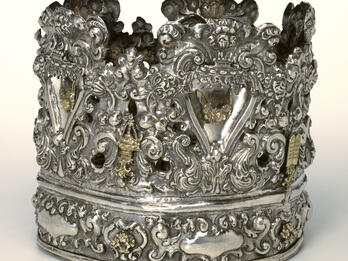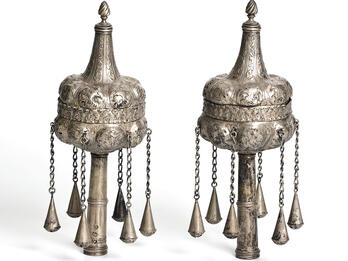Showing Results 1 - 10 of 102
Restricted
Image
This photo shows a reconstruction of the cella, or inner sanctum, of the Arad sanctuary as it is thought to have appeared in its last phase. At the rear stands a 35-inch-tall (90 cm) pillar of…
Places:
Arad, Land of Israel (Tel ‘Arad, Israel)
Date:
Iron Age IIA(?)–IIB, 9th (?)–8th Century BCE
Subjects:
Categories:
Restricted
Image
Though he later turned to a more abstract style, Elbert Weinberg was still making figurative sculptures in the early 1950s, when a trend toward pure abstraction was already dominant. But Ritual Figure…
Contributor:
Elbert Weinberg
Places:
Date:
1953
Subjects:
Categories:
Restricted
Image
This basin from Kuntillet Ajrud is much too large to have been used for a practical purpose—it weighs more than 300 pounds (136 kg) and is large enough for two adults to sit in. The inscription…
Places:
Kuntillet Ajrud, Land of Israel (Kuntillat Jurayyah, Egypt)
Date:
Iron Age II, Late 9th–Early 8th Century BCE
Subjects:
Categories:
Restricted
Image
In Ashkenazic communities, circumcision benches with two seats were sometimes used from the nineteenth century on, one for the sandek, the godfather on whose lap the baby boy is circumcised, and one…
Contributor:
Artist Unknown
Places:
Eidlitz, Holy Roman Empire (Údlice, Czech Republic)
Date:
ca. 1805
Subjects:
Categories:
Restricted
Image
This ewer and basin from Turkey were used to wash hands ritually during the Passover seder. Owned by the Benguiat family, a large and prominent Sephardic family in the Ottoman Empire, the objects…
Contributor:
Artist Unknown
Places:
Constantinople, Ottoman Empire (Istanbul, Turkey)
Date:
ca. 1845
Subjects:
Categories:
Restricted
Text
In the new religious revival, the theologians and philosophers have it easy; they can battle about the nature of revelation endlessly in the pages of Commentary. Parents and householders, on the other…
Contributor:
Ruth Gay
Places:
New York, United States of America
Date:
1951
Subjects:
Categories:
Restricted
Image
Jews first settled in Kaifeng, the capital of Henan province in central China, before 1127. According to scholars, they had come from India or Persia, spoke Persian, and worked as cotton dyers and…
Contributor:
Jean Domenge
Places:
Kaifeng, Qing Dynasty (Kaifeng, China)
Date:
1722
Subjects:
Categories:
Restricted
Image
These silver, crown-shaped Torah finials engraved with an okra floral motif are from the Paradesi Synagogue in Kerala, India. A Hebrew inscription (divided into four parts) reads: “The honorable R…
Contributor:
Artist Unknown
Places:
Dutch Colonial Empire (Kerala, India)
Date:
1721
Subjects:
Categories:
Restricted
Image
This silver Torah crown from Padua, Italy, is decorated with images of the tablets of law, incense utensils, the ark of the covenant,
and the headdress of the high priest.
Contributor:
Artist Unknown
Places:
Padua, Venice (Padua, Italy)
Date:
17th–18th Century
Subjects:
Categories:
Restricted
Image
These silver Torah finials are from Corfu and were made between the seventeenth and eighteenth centuries, by an artist whose initials were A.Z. They were used in the Scuola Greca Synagogue, which…
Contributor:
A.Z.
Places:
Kérkyra (Corfu), Ottoman Empire (Corfu, Greece)
Date:
Late 17th–Early 18th Century


